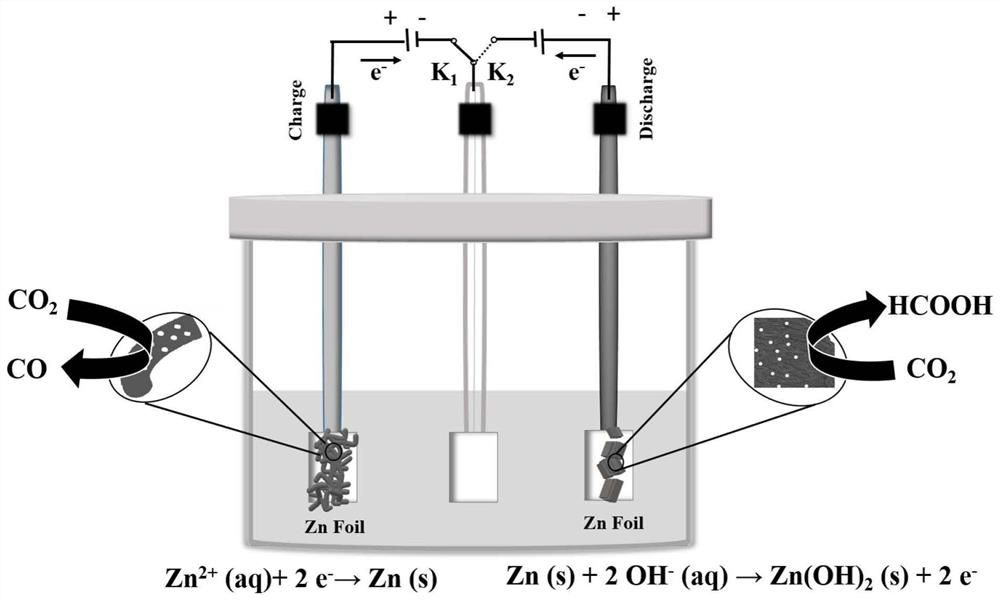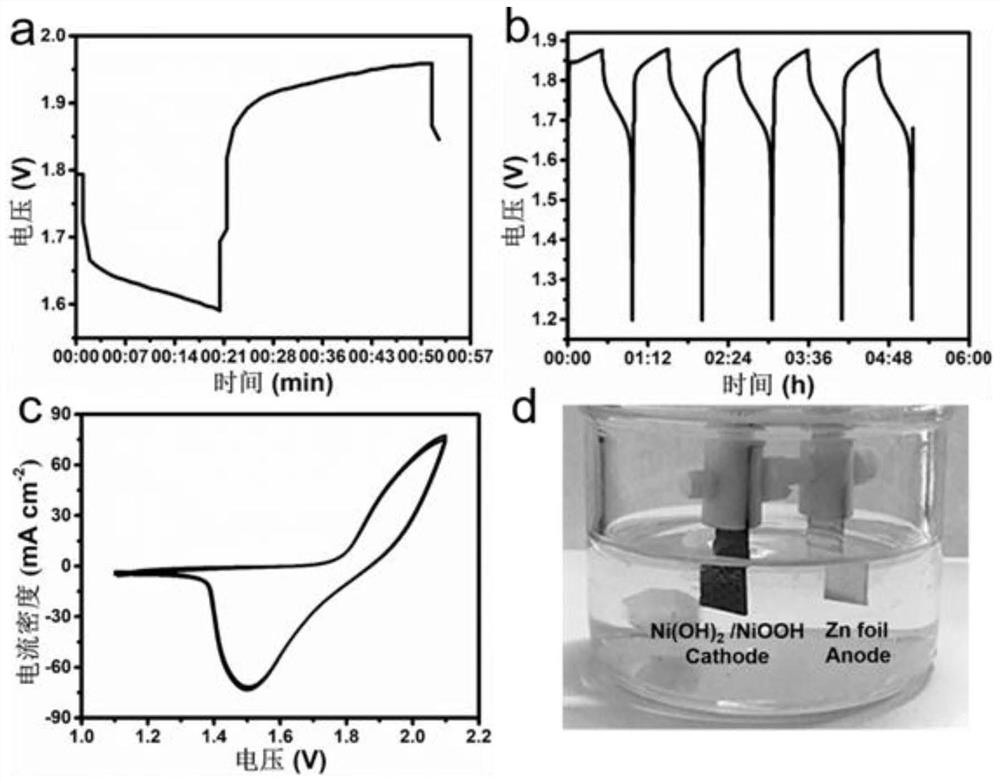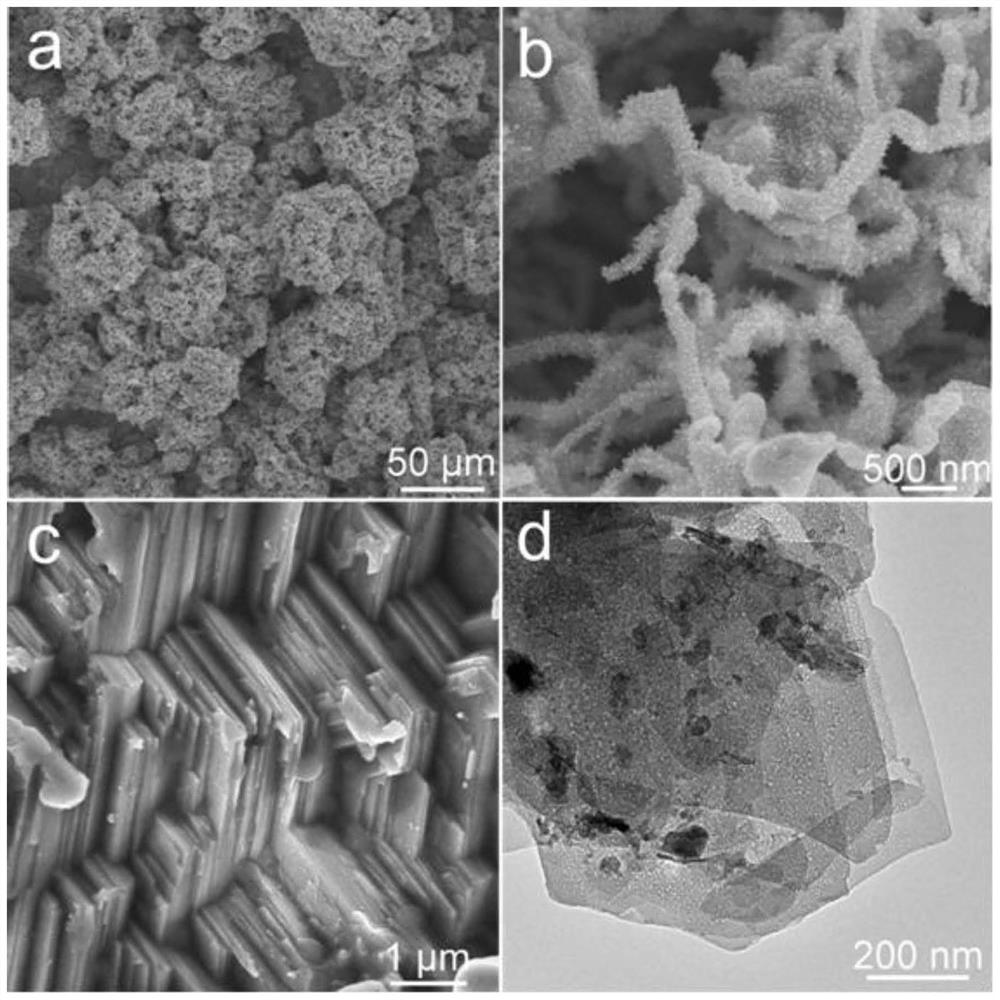Application of Regenerative Electrode of Zinc-ion Battery in Electrochemical Reduction of Carbon Dioxide
A zinc-ion battery, carbon dioxide technology, applied in the direction of electrodes, electrolytic organic production, electrolytic components, etc., can solve the problems of low conversion rate, high energy consumption, limited high-efficiency utilization, etc., and achieve the effect of high selectivity
- Summary
- Abstract
- Description
- Claims
- Application Information
AI Technical Summary
Problems solved by technology
Method used
Image
Examples
Embodiment 1
[0053] (1) Carry out corrosion and regeneration treatment on the zinc sheet negative electrode by charging and discharging the nickel-zinc battery, specifically: the nickel electrode is a commercial sintered nickel electrode (nickel oxyhydroxide / nickel hydroxide), and the purity of the zinc negative electrode is 99.9%- 99.99% zinc flakes, zinc oxide or zinc oxalate saturated 6M potassium hydroxide as electrolyte. Finally, for the assembly of the battery ( figure 2 ), using the blue electric battery test system to conduct charge and discharge tests on nickel-zinc batteries.
[0054] (2) By adjusting the charge and discharge conditions: charge and discharge current density (10, 20, 30mA cm -2 ), charge and discharge cycles (1, 2, 3, 4, 5), charge time (10, 20, 30, 40, 50 minutes), discharge cut-off voltage (1.0, 1.2, 1.4, 1.6V) and constant Voltage charge and discharge, etc., to corrode and regenerate the zinc sheet negative electrode. By controlling the above experimental p...
Embodiment 2
[0075] (1) Carry out corrosion and regeneration treatment on the zinc sheet negative electrode by charging and discharging the nickel-zinc battery, specifically: the nickel electrode is a commercial sintered nickel electrode (nickel oxyhydroxide / nickel hydroxide), and the purity of the zinc negative electrode is 99.9%- 99.99% zinc flakes, 6M potassium hydroxide saturated with zinc oxide as electrolyte. Finally, for the assembly of the battery ( figure 2 ), using the blue electric battery test system to conduct charge and discharge tests on nickel-zinc batteries.
[0076] (2) The last step of the control is charging, the charge and discharge current density is 20mA cm -2 , the number of charge and discharge cycles is 1 cycle, the discharge time is 20 minutes, the charging time is 30 minutes, the temperature of the electric test room is 25 ° C, and the zinc sheet negative electrode is corroded and regenerated. Zinc@zinc oxide nanowires with a core-shell structure will be gene...
Embodiment 3
[0081] (1) Carry out corrosion and regeneration treatment to the zinc sheet negative electrode by charging and discharging the zinc-air battery, specifically: the air electrode is commercial activated carbon (sprayed on foamed nickel), and the zinc negative electrode has a purity of 99.9%-99.99% Zinc sheet, zinc oxide or zinc oxalate saturated 6M potassium hydroxide as electrolyte. Finally, for the assembly of the battery ( Figure 10 ), the battery shell is made of PMMA material, and the charge and discharge test of the zinc-air battery is carried out by using the blue electric battery test system. Figure 10 Schematic diagram of the zinc-air battery setup.
[0082] (2) By adjusting the charge and discharge conditions: charge and discharge current density (10, 20, 30mA cm -2 ), charge and discharge cycles (1, 2, 3, 4, 5), charge time (10, 20, 30, 40, 50 minutes), discharge cut-off voltage (1.0, 1.2, 1.4, 1.6V) and constant Voltage charge and discharge, etc., to corrode and...
PUM
| Property | Measurement | Unit |
|---|---|---|
| diameter | aaaaa | aaaaa |
| thickness | aaaaa | aaaaa |
Abstract
Description
Claims
Application Information
 Login to View More
Login to View More - R&D
- Intellectual Property
- Life Sciences
- Materials
- Tech Scout
- Unparalleled Data Quality
- Higher Quality Content
- 60% Fewer Hallucinations
Browse by: Latest US Patents, China's latest patents, Technical Efficacy Thesaurus, Application Domain, Technology Topic, Popular Technical Reports.
© 2025 PatSnap. All rights reserved.Legal|Privacy policy|Modern Slavery Act Transparency Statement|Sitemap|About US| Contact US: help@patsnap.com



